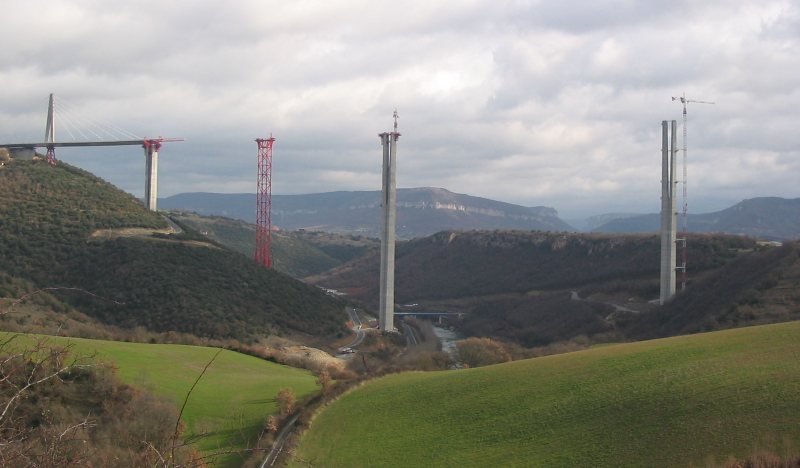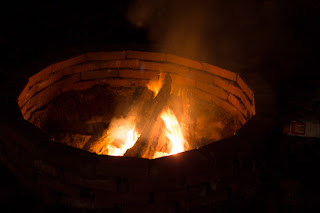A bridge, by its nature, is always going over something. The vast majority of the time, this means that the height of the road approaching the bridge is artificially elevated. That's true for water features or other natural crossing, but it is in particular, true for "grade separation" bridges. Bridges where the point is to run one road over another.
Typically, the road surface beneath is lowered a bit by excavating out, while the above road surface is raised by adding "fill", which is just a slightly fancier word for soil (which itself is just another word for dirt, but as a geotechnical professor always told me: "Call it soil, no one is going to pay you to play with dirt"). However you do it, these kind of elevation separations require some kind of transition between the higher elevation of the soil above and the lower elevation of the road below.
 |
| This bridge (by Hoover Dam) has natural rock walls holding up the roadway leading onto the bridge. Most situations require some kind of engineering to create a grade separation. |
One solution is to just grade the soil down from high to low. Which basically just means sloping the soil from high to low. The old Greenfield bridge was this way, and some states, including Wisconsin, prefer this solution. However, there are some draw backs to it. Though it makes that transition cheap (essentially just the cost of some dirt) it takes up a lot of space and the bridge then has to span over all that extra distance.
 |
| Notice the span at the end. Underneath that span, the "grade", meaning the surface of the earthwork there, slopes up from the road below to meet the road above. In this case the slope is steep enough that concrete was placed on top to keep the soil from shifting. The bridge needed to add an extra span just to go over this sloping soil. |
The absolute steepest soil is typically allowed to slope upward is a 2:1 grade. Meaning that for every two feet you move horizontally you can only go one foot up. At this steep of a slope, you need to pour concrete on top of the slope to keep it from moving. If it's just soil (no concrete or other binders) then 2.5:1 or 3:1 is where you need to be. When you're in tight quarters, or just want to save costs on the bridge (by not making it span these extra distances) then you can save space by adding in a retaining wall.
 |
| The name plate for the wall on the West side of the Greenfield bridge. All states have some way of designating the structures they build. Here the 'R' refers to "R"etaining wall, and the numbers indicate the region it's built in as well as a unique identifier that's assigned pseudo-randomly. |
Retaining walls, meaning walls that keep, or retain, the earth from spilling over on top of whatever is beneath them, come in two, general varieties. The first is a "cut" wall, this is when the earth is already as high as you want it to be, so you cut a wall into it and then remove the soil in front of the wall. Greenfield has such a wall on its East side, though sadly I wasn't able to get any good pictures of it.
 |
| Building a cut wall, in this case a "soldier pile" wall. When they've finished placing it, they'll excavate the soil in front of those steel piles: that's the"cut" portion of the wall. |
At Greenfield, it was a "tangent pile wall". This means drilling holes into the soil and filling those holes with concrete and rebar. The holes are drilled tangentially to each other, i.e. touching each other, thus the name. The bridge will sit directly on top of the concrete shafts, and so the wall is designed to resist both the force of the soil behind it and the force of the bridge on top.
 |
| The West wall at Greenfield is a "fill" wall. A fancy looking pattern is cast into the facing, but at it's structural simplest, this is just a collection of flat, precast, concrete panels all stacked up next to each other. |
The second kind of wall is a "fill" wall. Which is exactly what it sounds like: you put a wall where there isn't enough soil and fill it with soil. Most such walls, at least here in the States (and my guess is this is true just about everywhere), are "MSE" walls. With "MSE" standing for Mechanically Stabilized Earth. The way it works is you take a panel (typically a 5'x10' or just 5'x5') that's around 5"-7" thick and attach straps to the back of it. The straps can be just standard rebar, or the can be a specially designed plastic netting. Their main purpose is to engage the soil that's going to go behind the wall. Or in other words make it so that when the panel gets pushed out by the weight of the soil behind it, it pulls on the soil, whose weight stops it from actually going forward. In other words: the soil anchors itself.
A panel with straps is placed with no soil behind it. Then a "lift" (or layer) of soil is placed on top of the straps and compacted. It needs to be compacted because it will settle eventually and you want to make sure there are no gaps, no strange settlements, and that the final surface of the soil doesn't change elevation. Then, when that panel has been filled up, you place another panel on top of it and put down some more lifts.
 |
| Because space is at a premium both from an availability and cost perspective, transportation-related walls tend to be straight. But nothing says you can't slope them. |
Like the bridge, the soil you want around the wall itself is sand to ensure drainage (an actual drain is placed along the back of all these walls, leading to an inlet somewhere that connects into the storm drains). But the wall has additional excavation behind the actual, stabilized part, and that can be just about any kind of soil.
Many situations, if not most, aren't clearly in a "cut" or "fill" category. Maybe there's a soil layer that goes up 8' but you need 20'. In those cases, and in fact in every case, it is function followed by cost that determines what kind of wall you use. The actual function may just be to hold up soil, but it could be it also has to allow utilities to travel behind it or bear the weight of a structure. If that's the case, sometimes more expensive walls are used because the cheaper versions aren't as functionally flexible. For a fill wall, there has to be a lot of excavation behind the wall itself (remember the 2:1 thing? That holds true for temporary, construction situations as well, though contractors will try to get away with 1.5:1 or sometimes even 1:1 slopes). There's not always room to do that, especially for very tall walls.
After function is determined and met, cost drives wall selection. There are many situations where the wall is in an entirely cut condition, meaning the existing soil level is already at or above what will be needed in the final condition, but a MSE (fill) wall is used. MSE walls are really cheap, and so any chance to use them is jumped at. It seems a bit silly to excavate all this soil to build it and then fill it back up,but that is often cheaper than building a cut wall. So Greenfield had one cheap wall (MSE) and it also had the most expensive wall type we use: the tangent wall. A nice mix.

















































